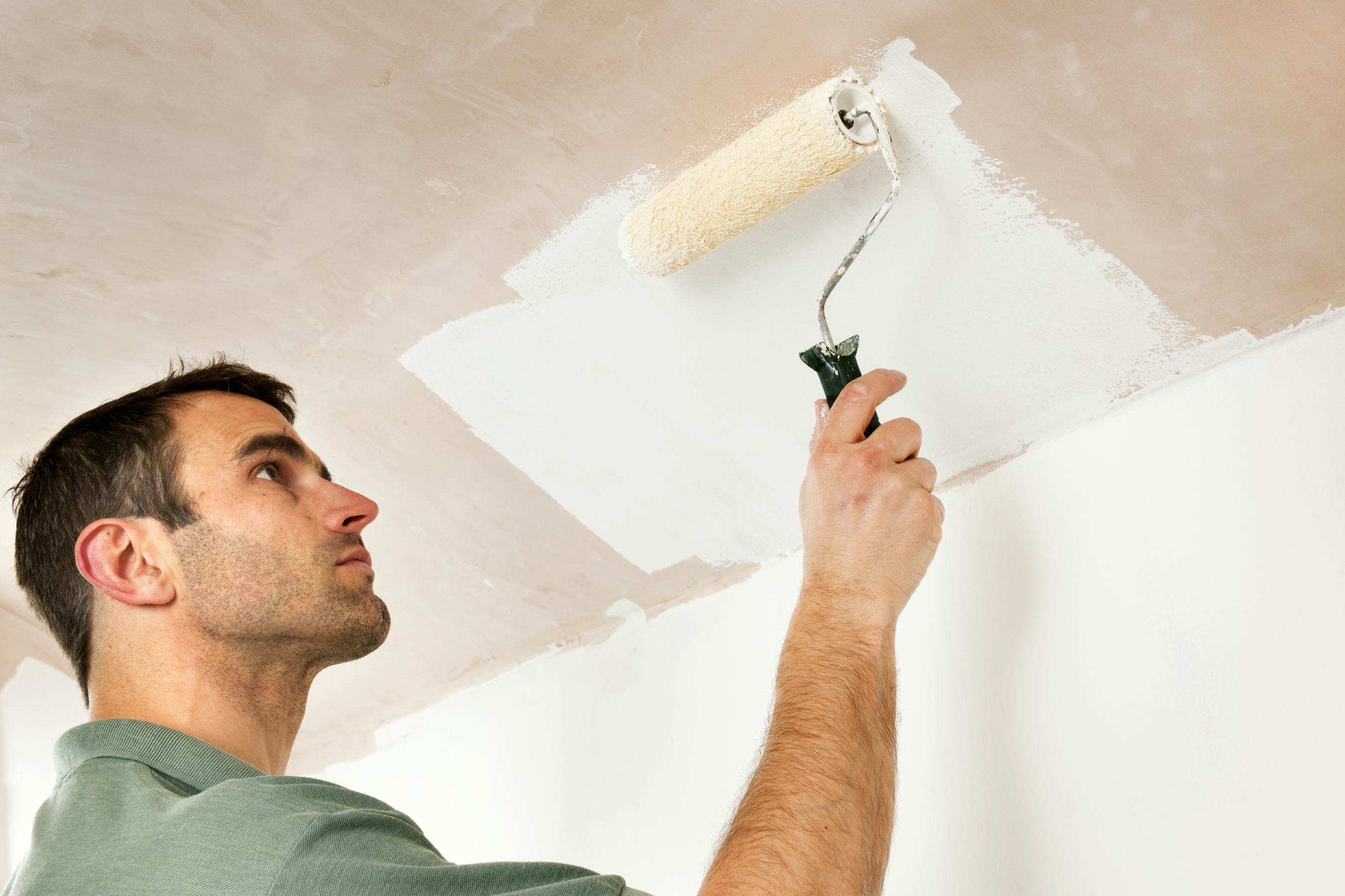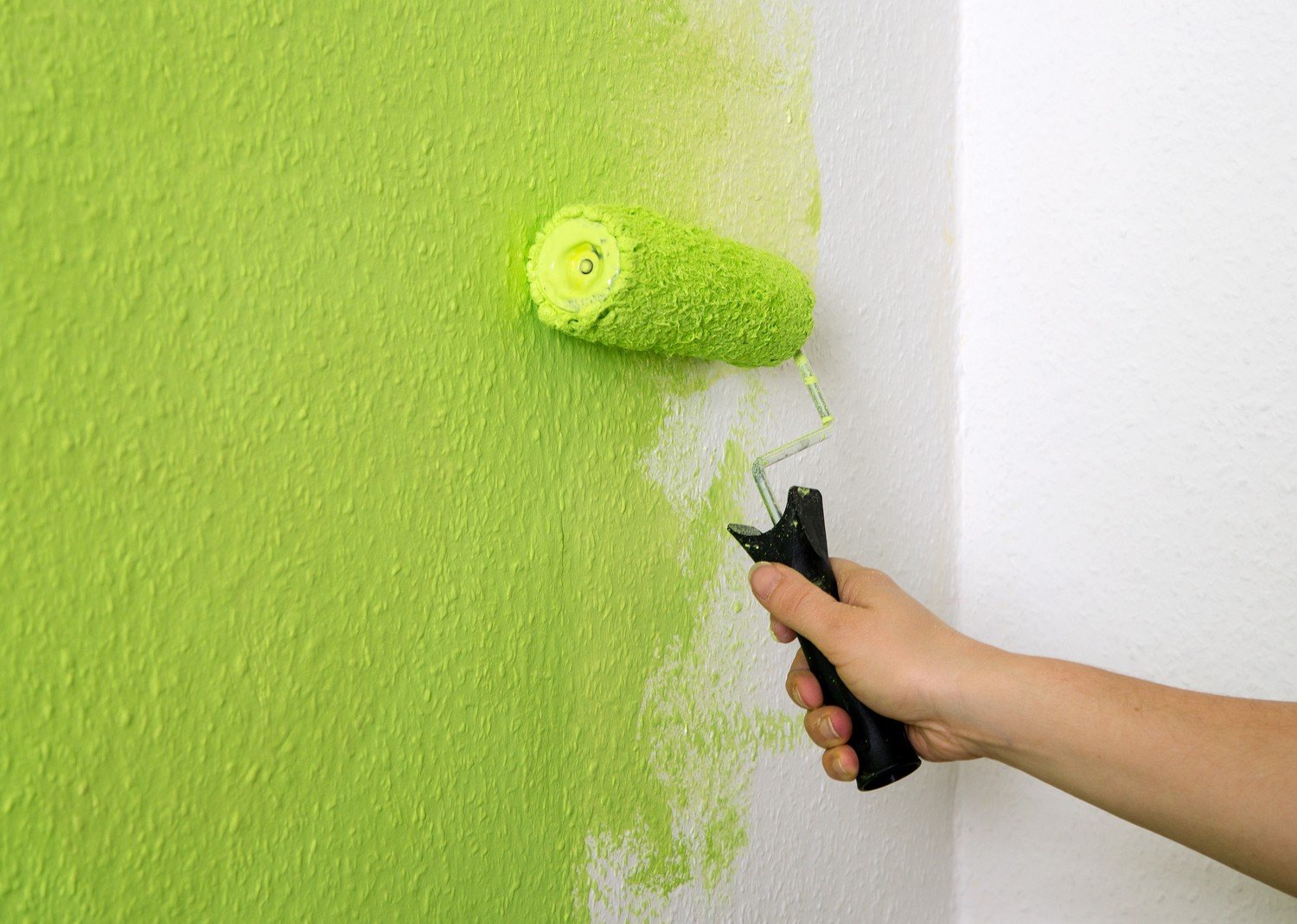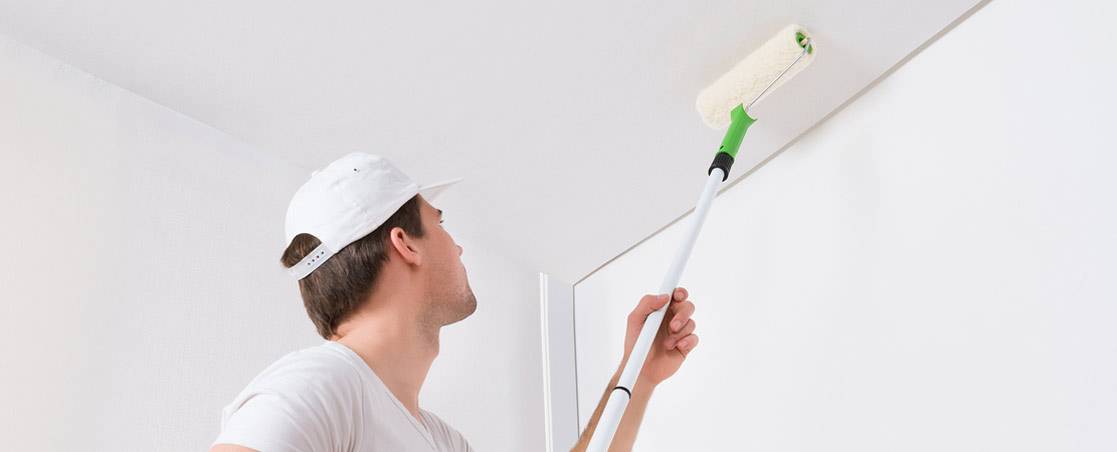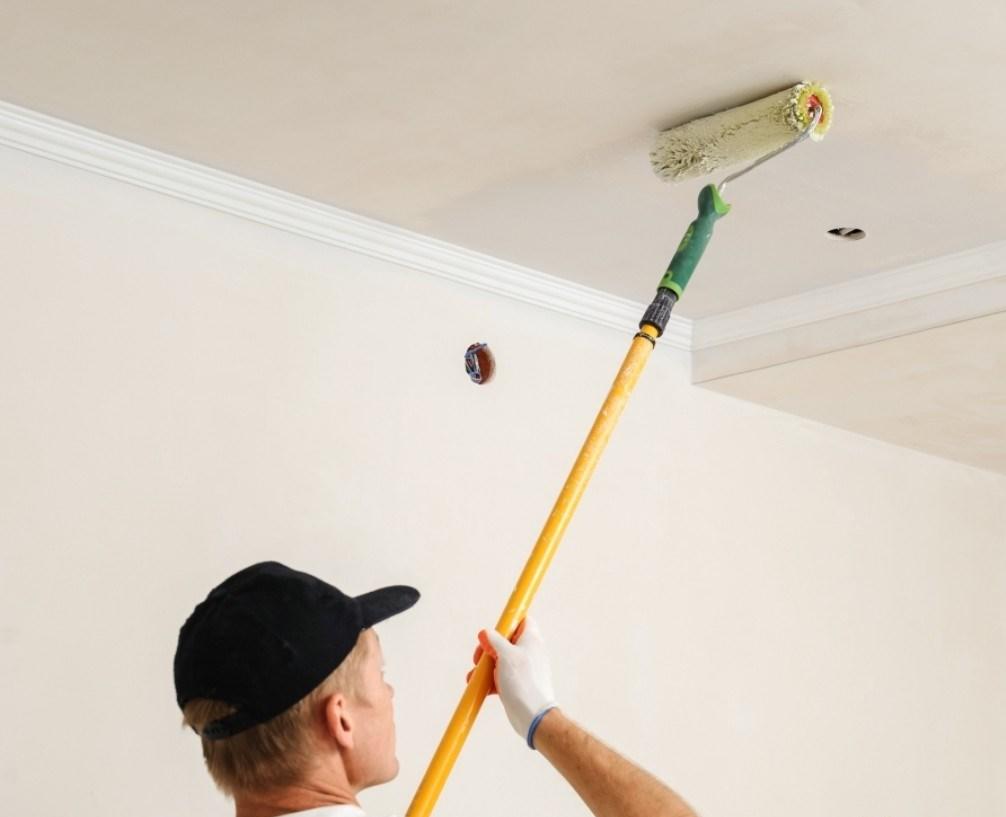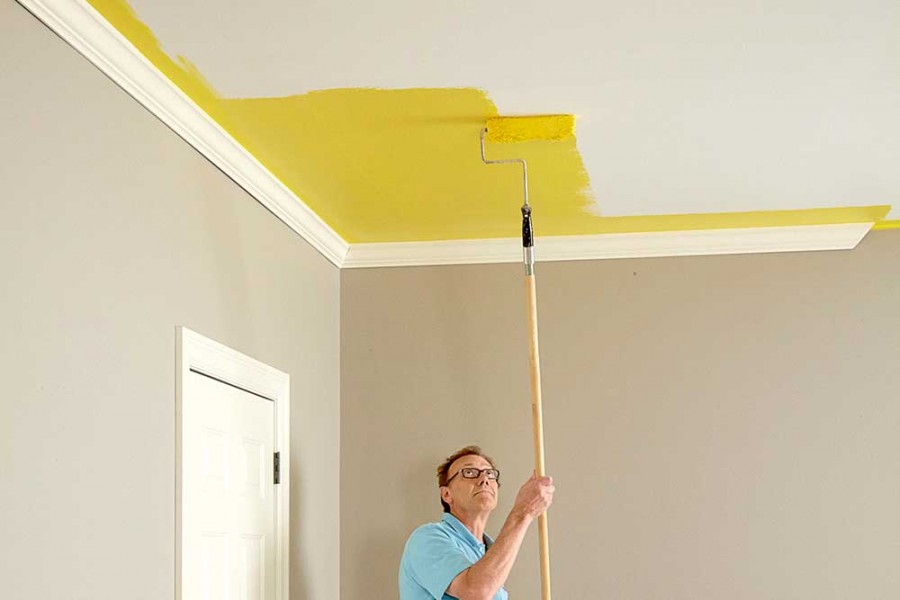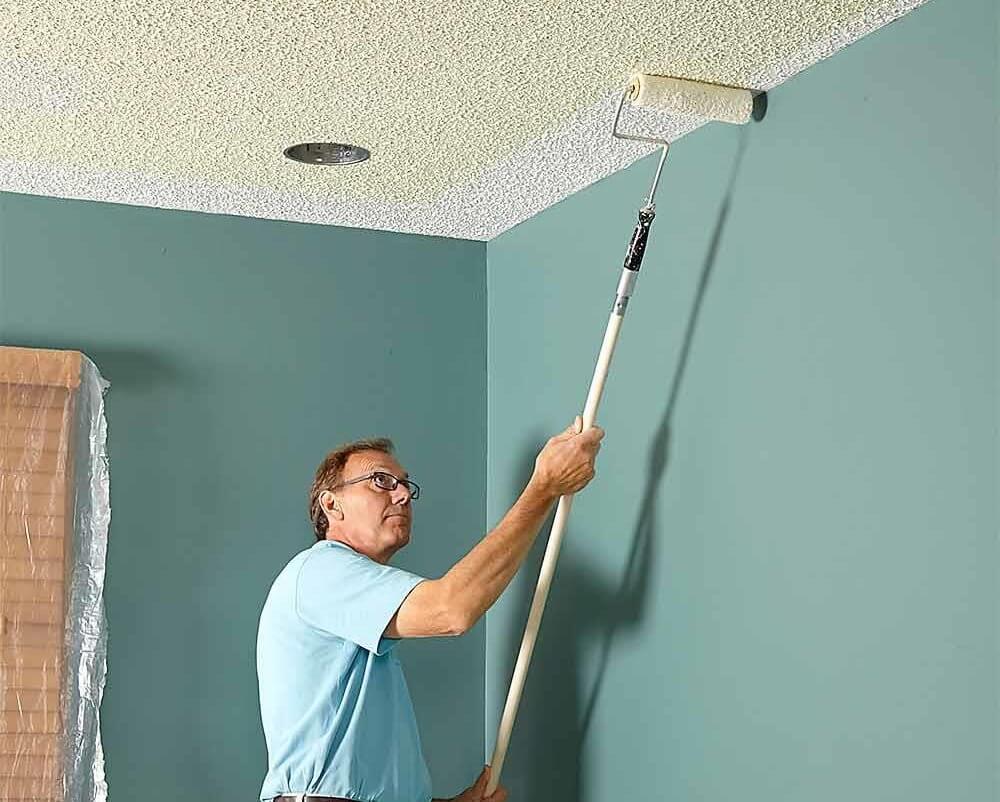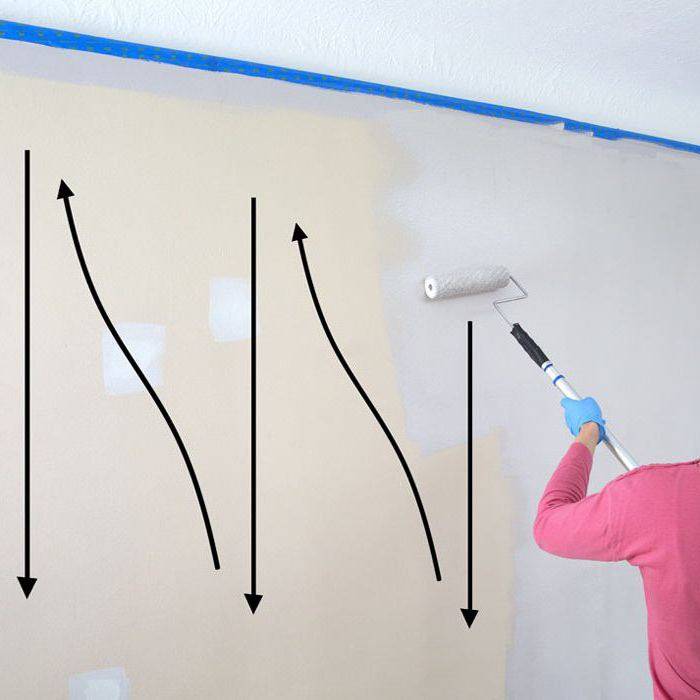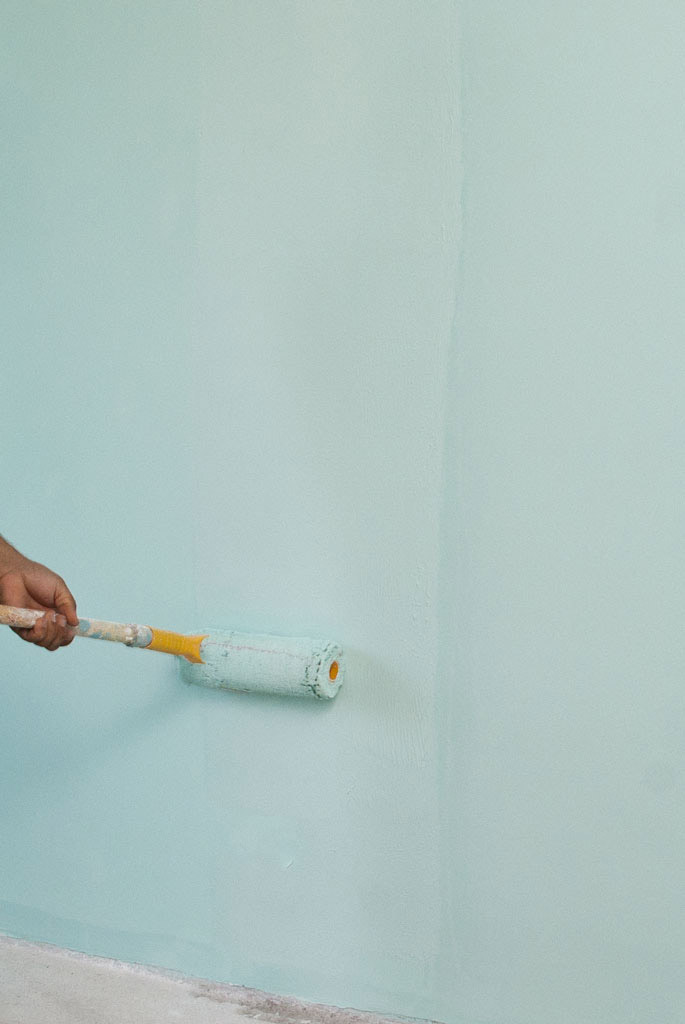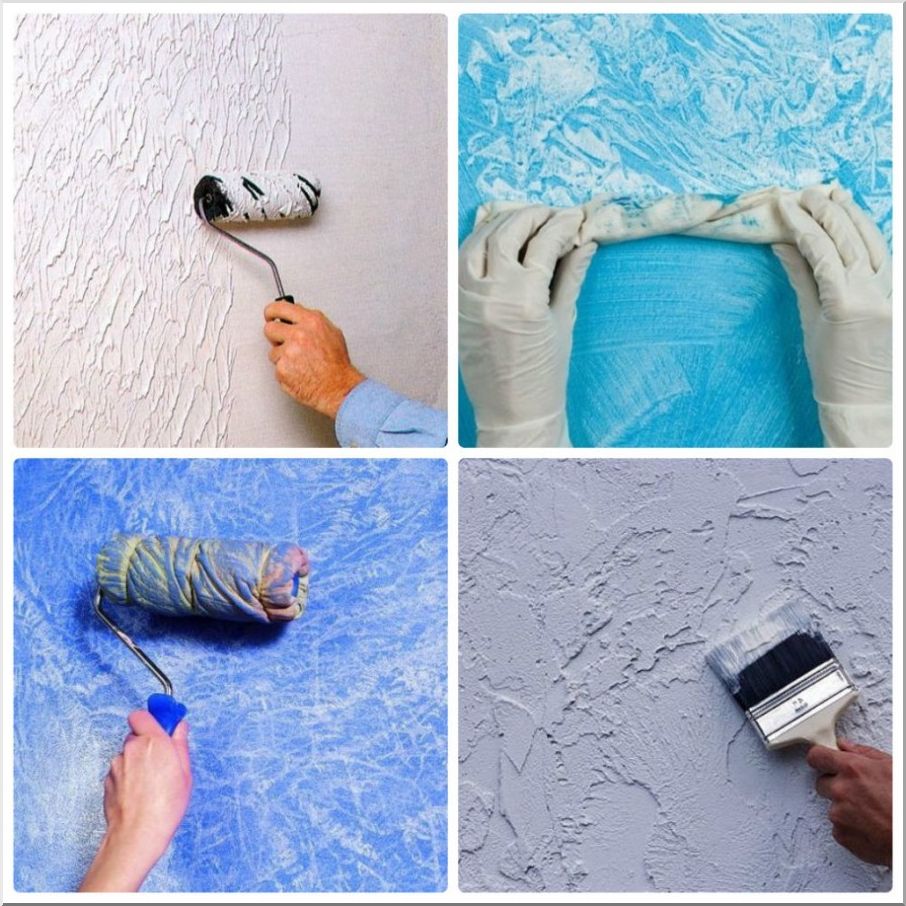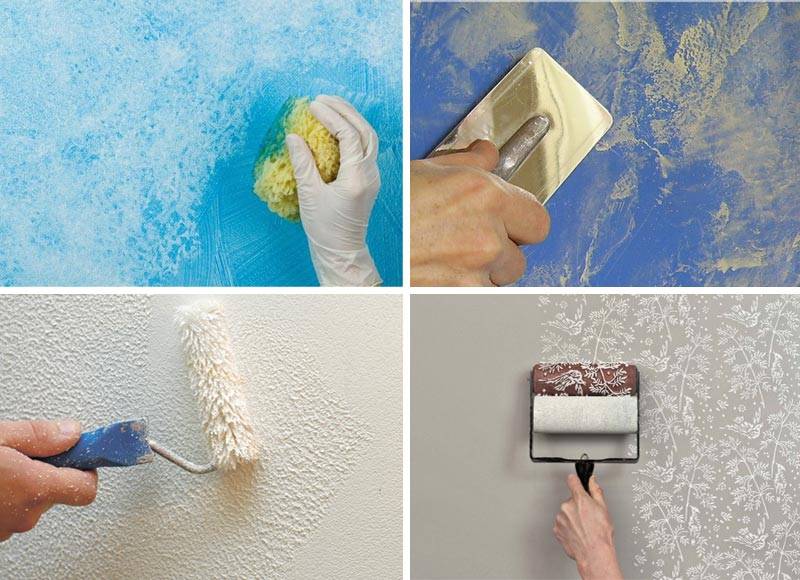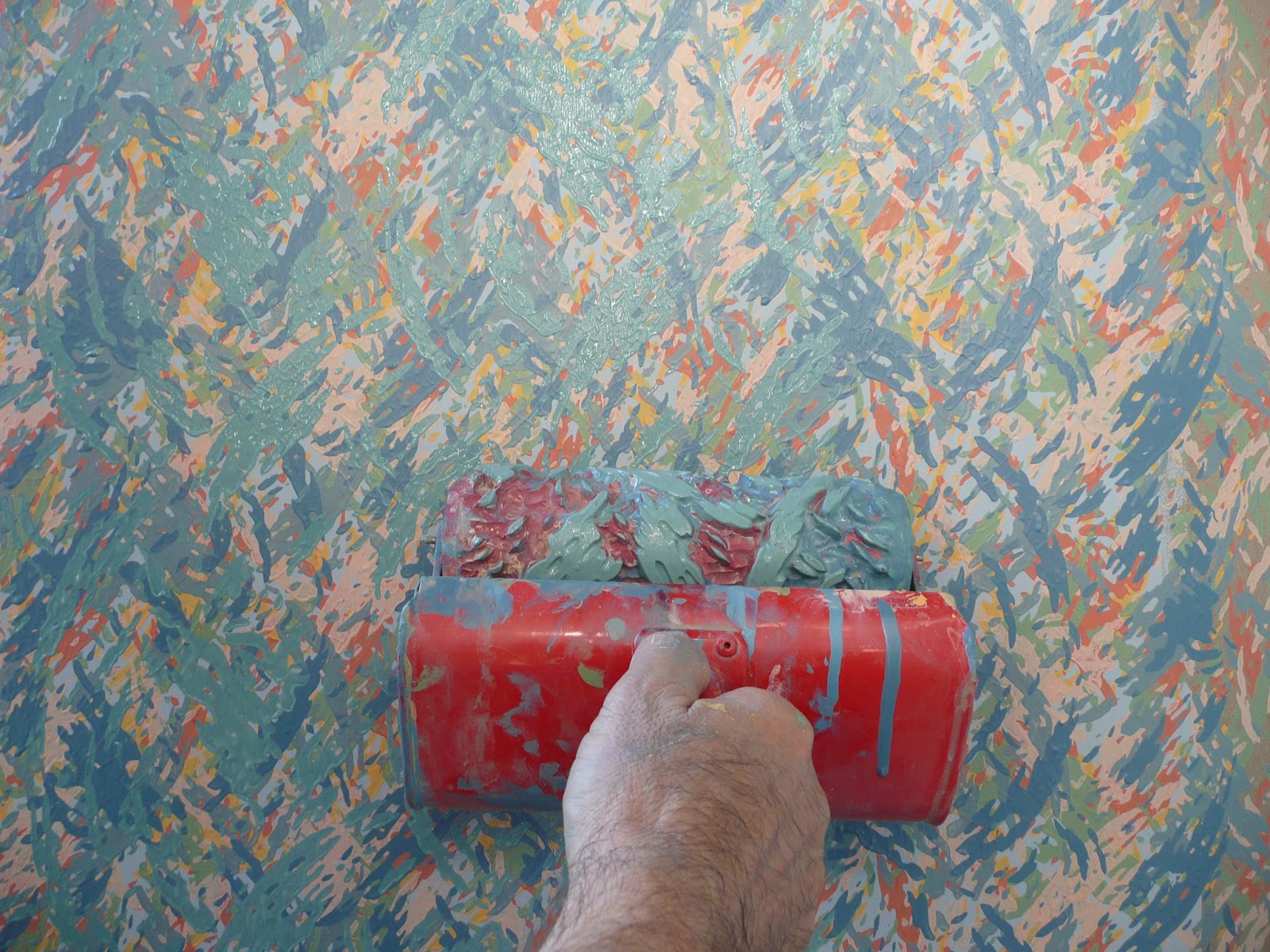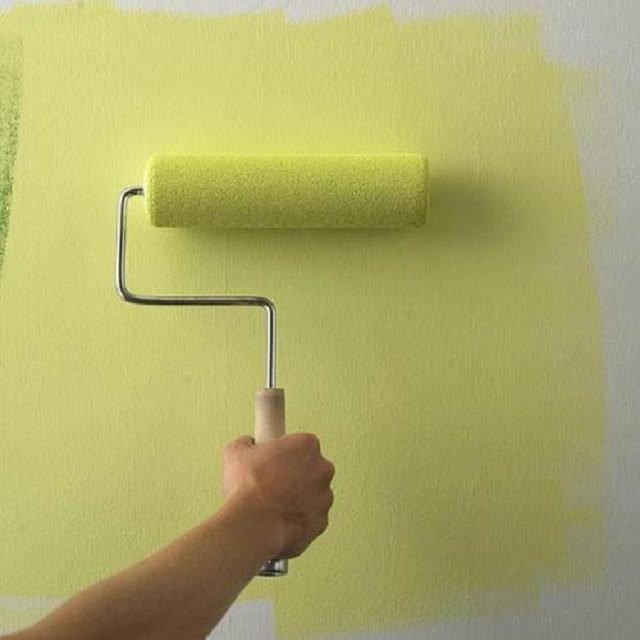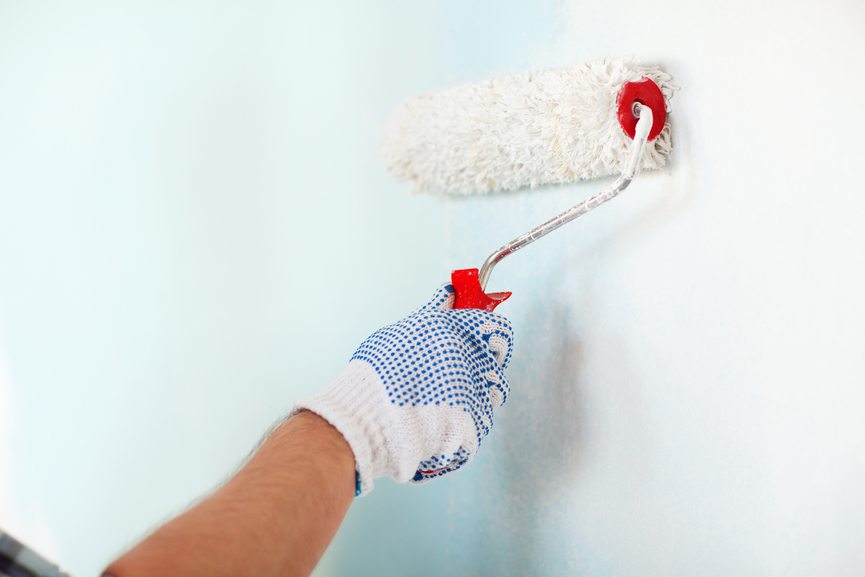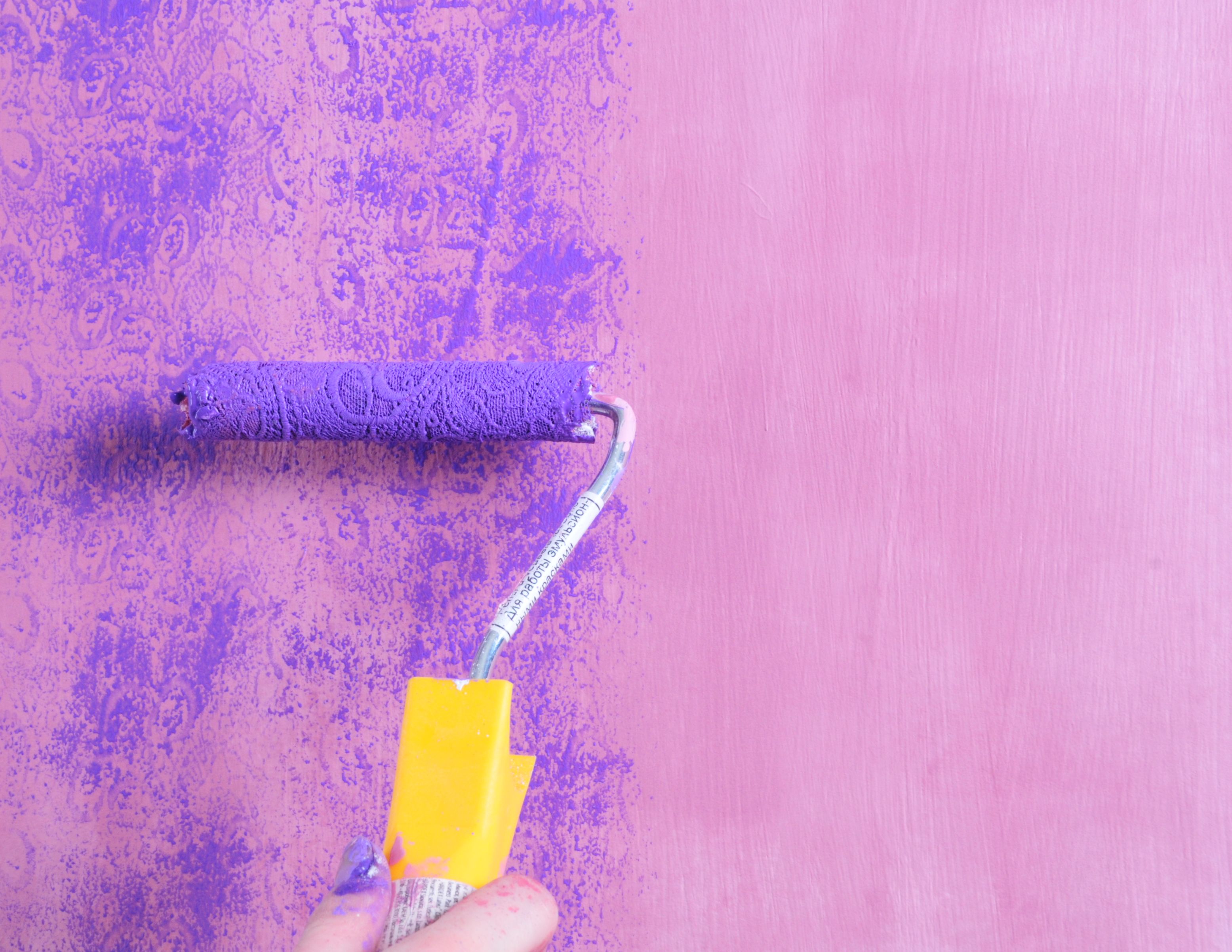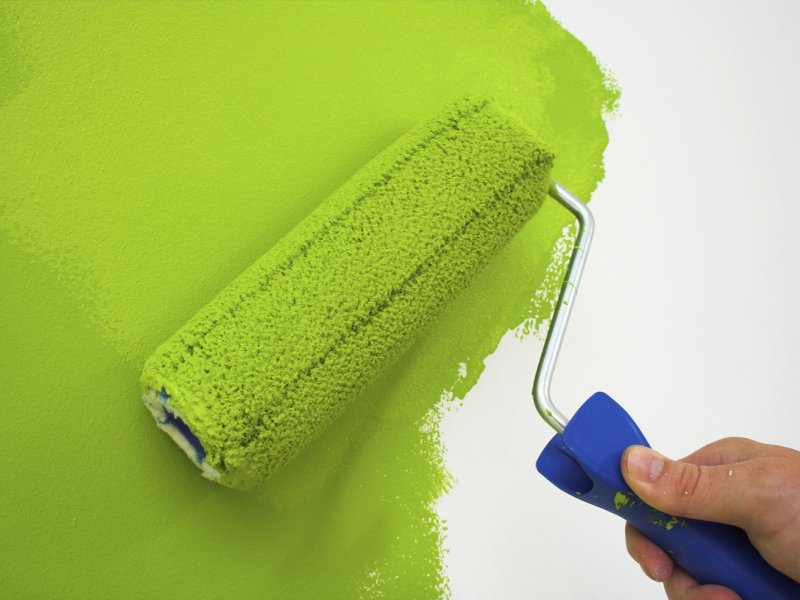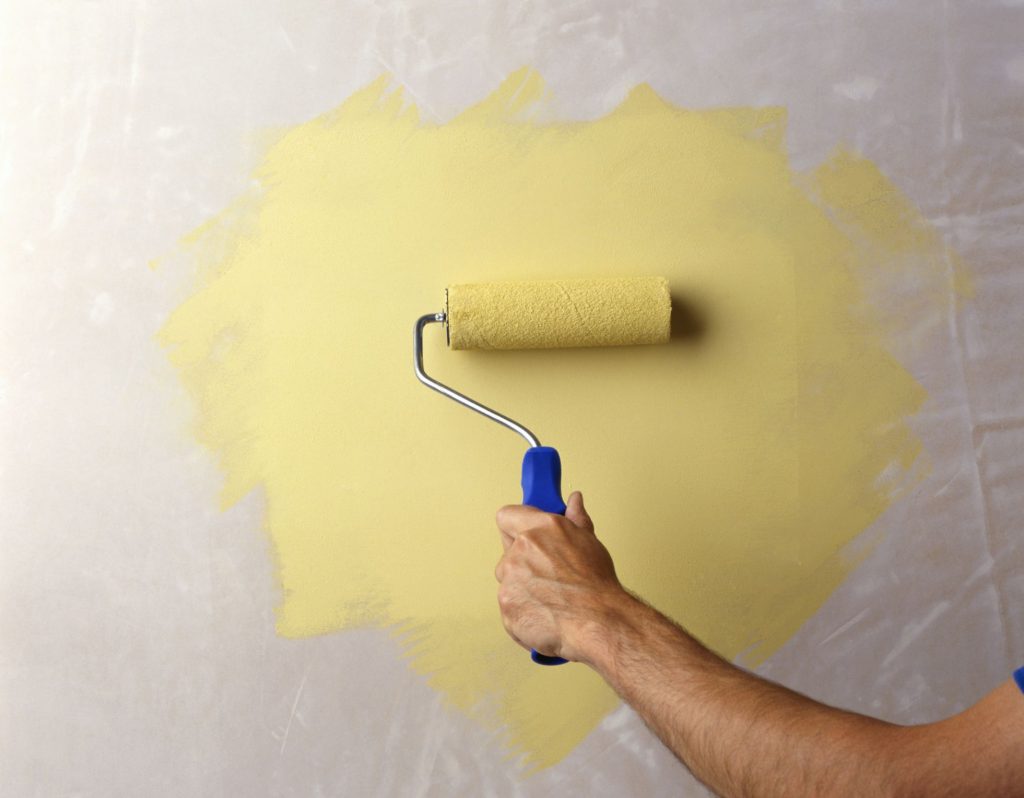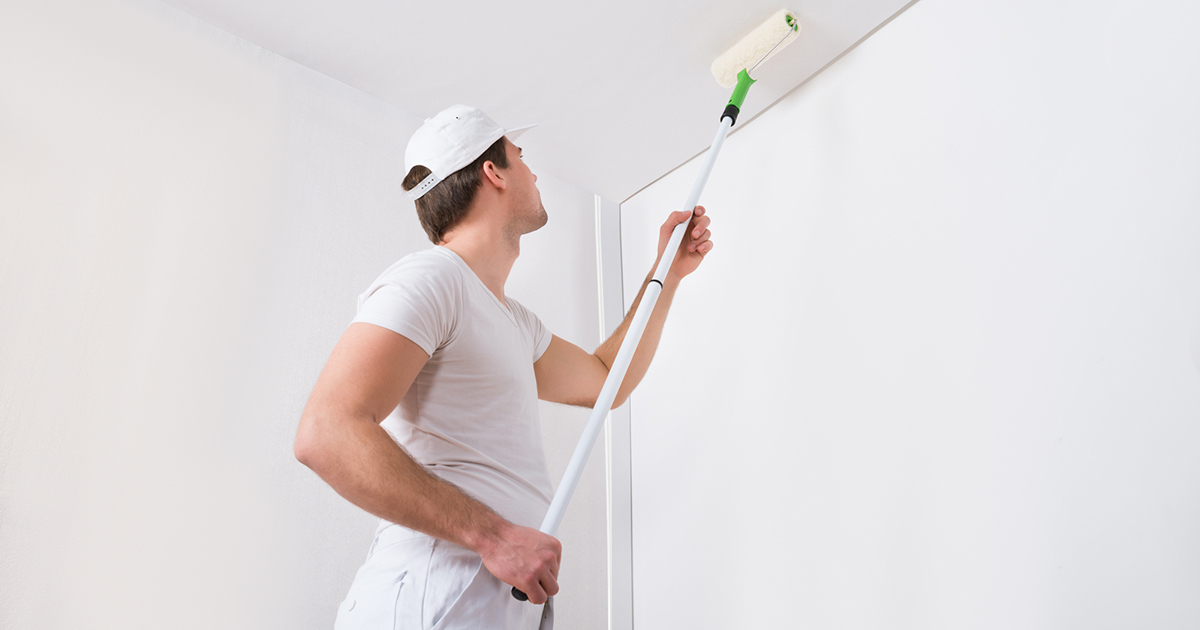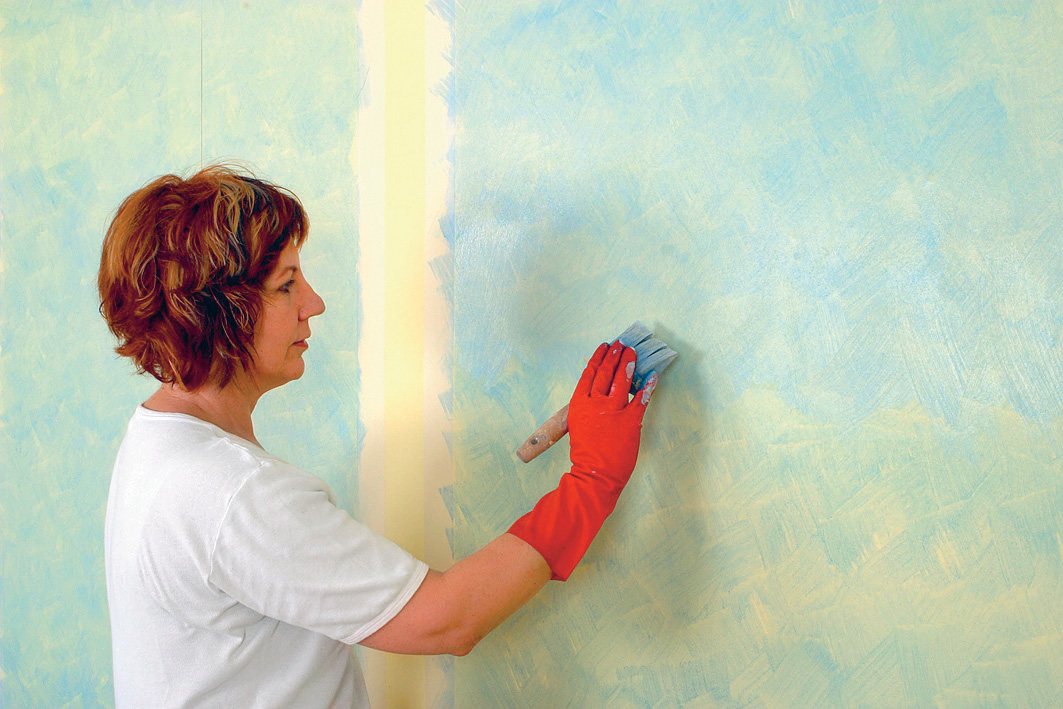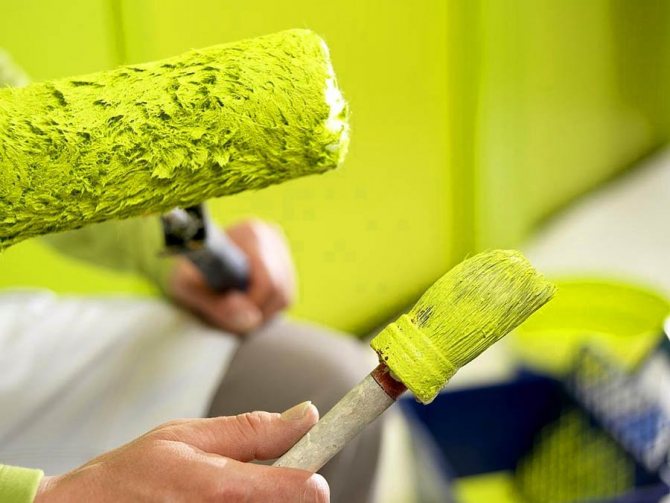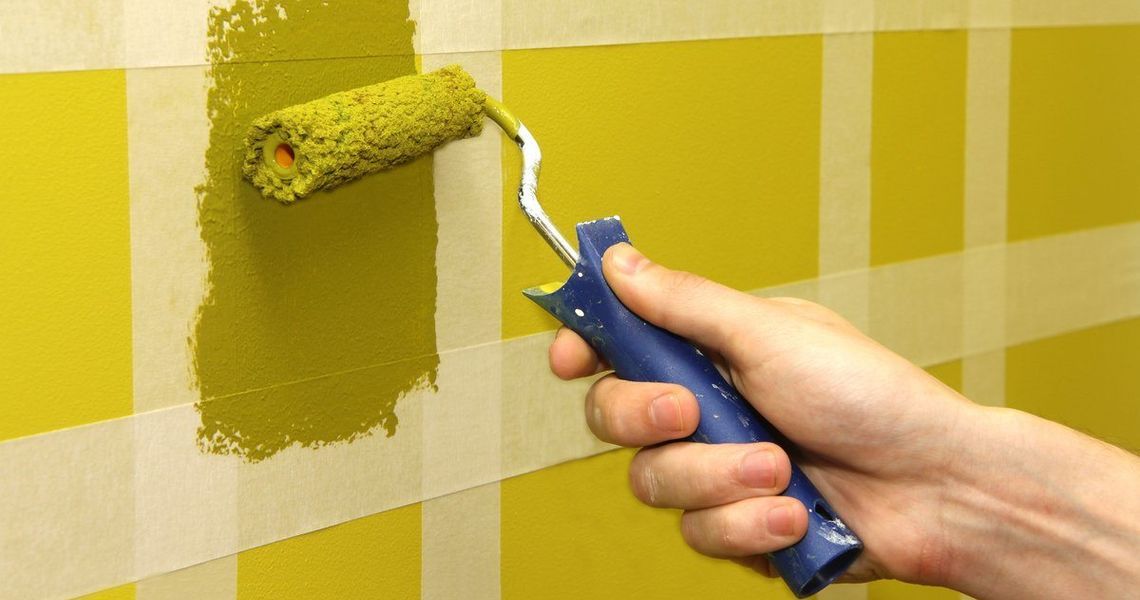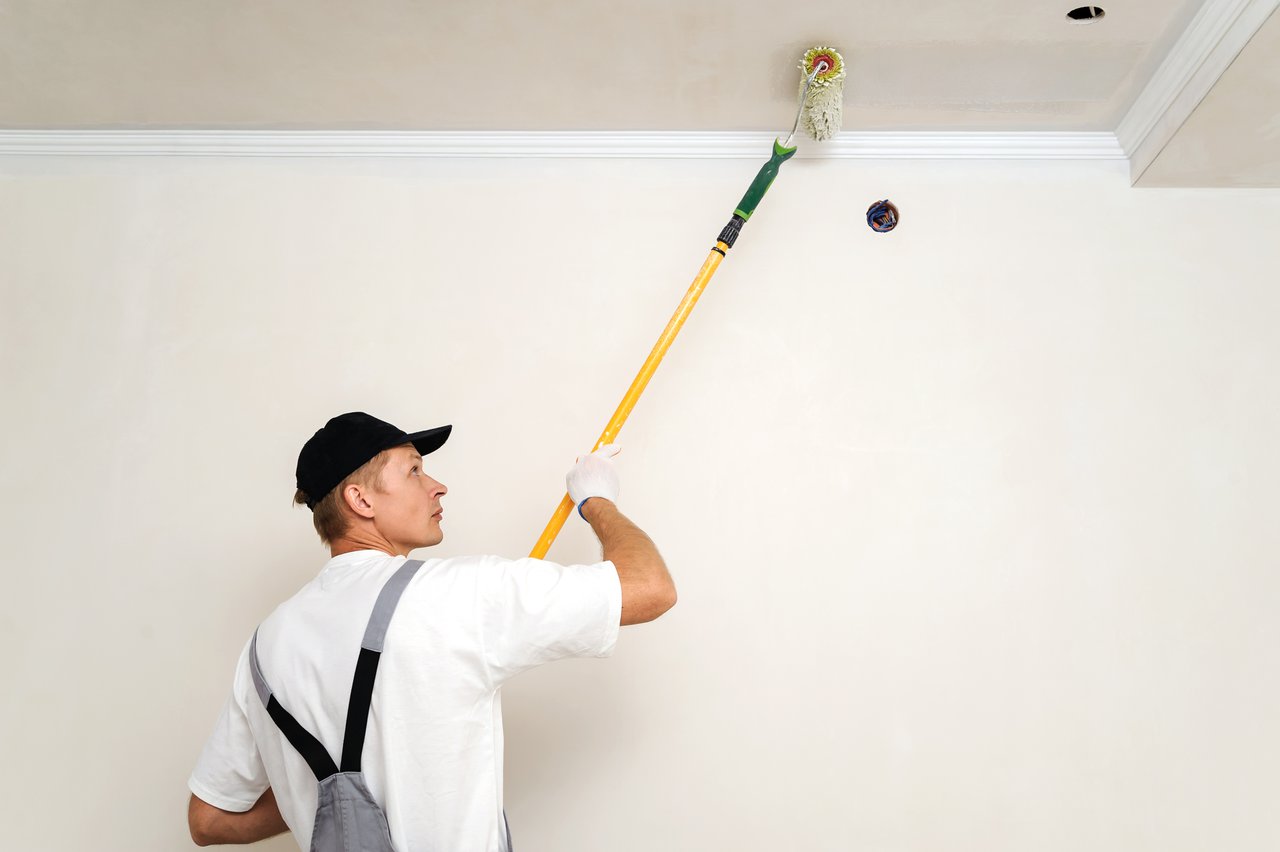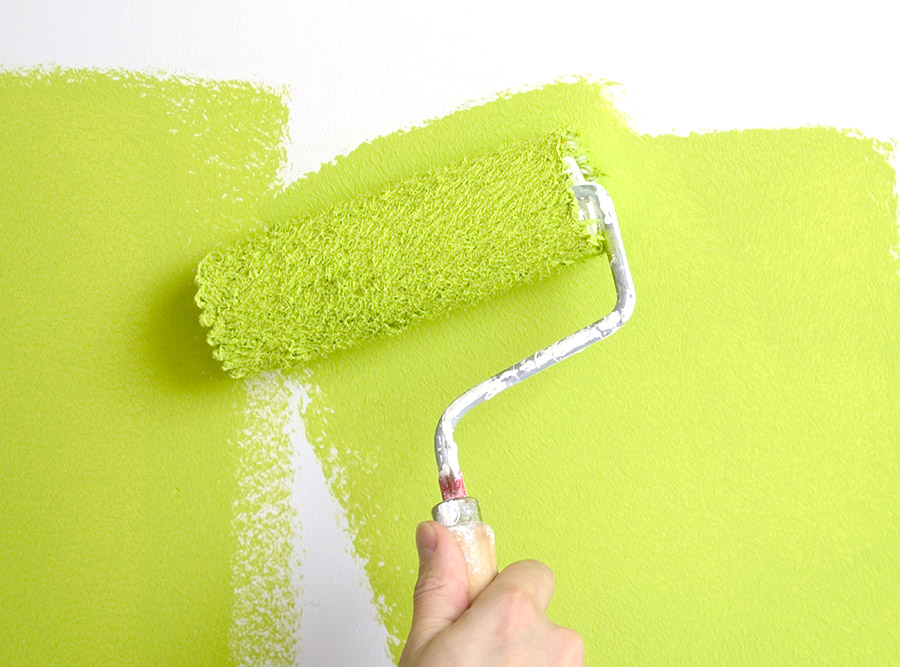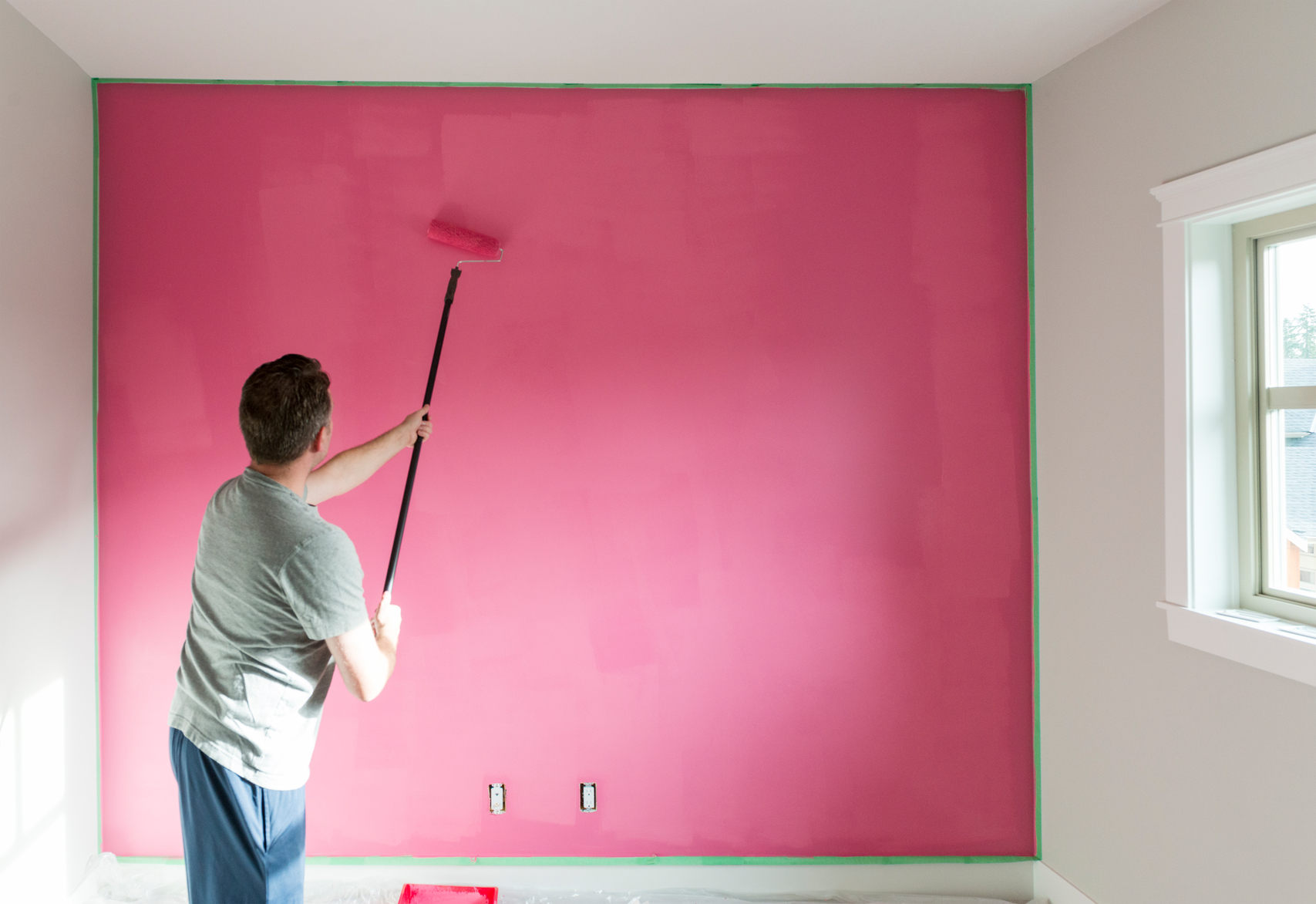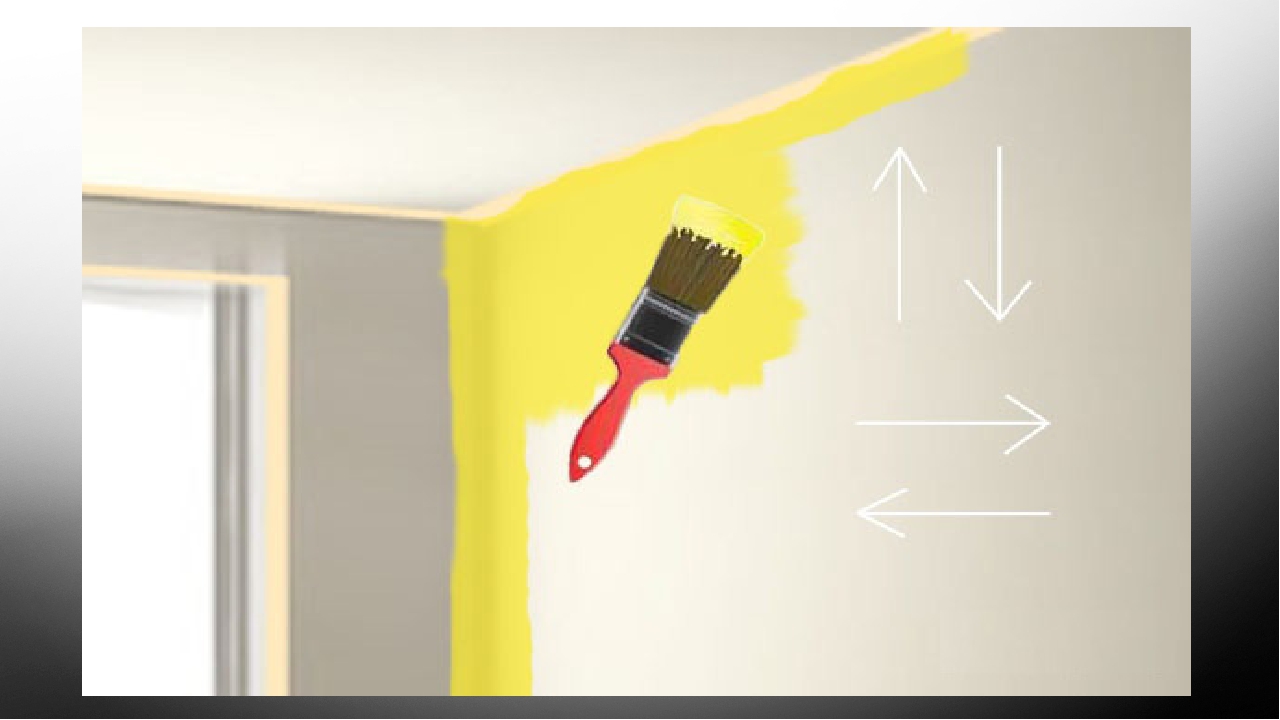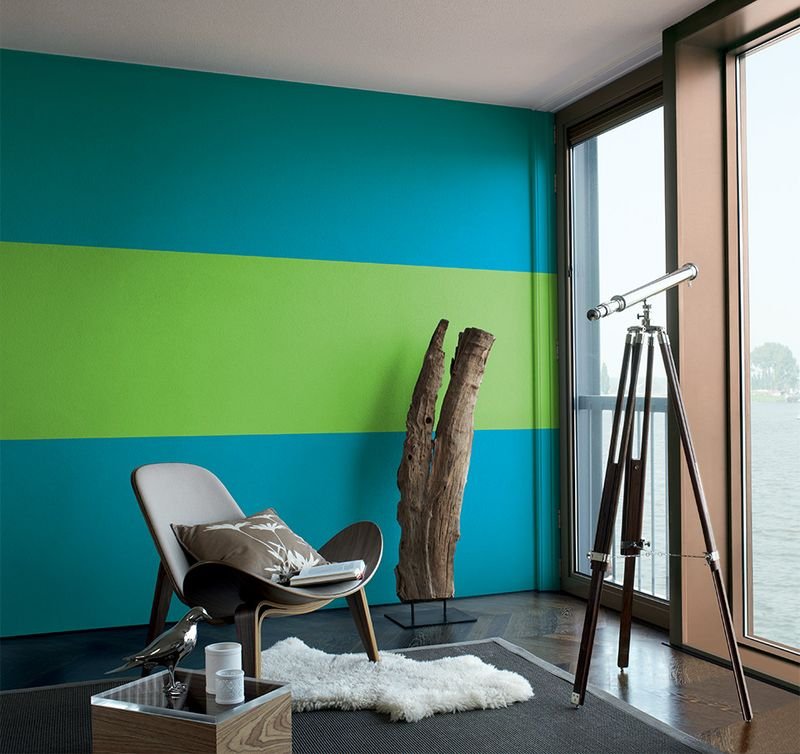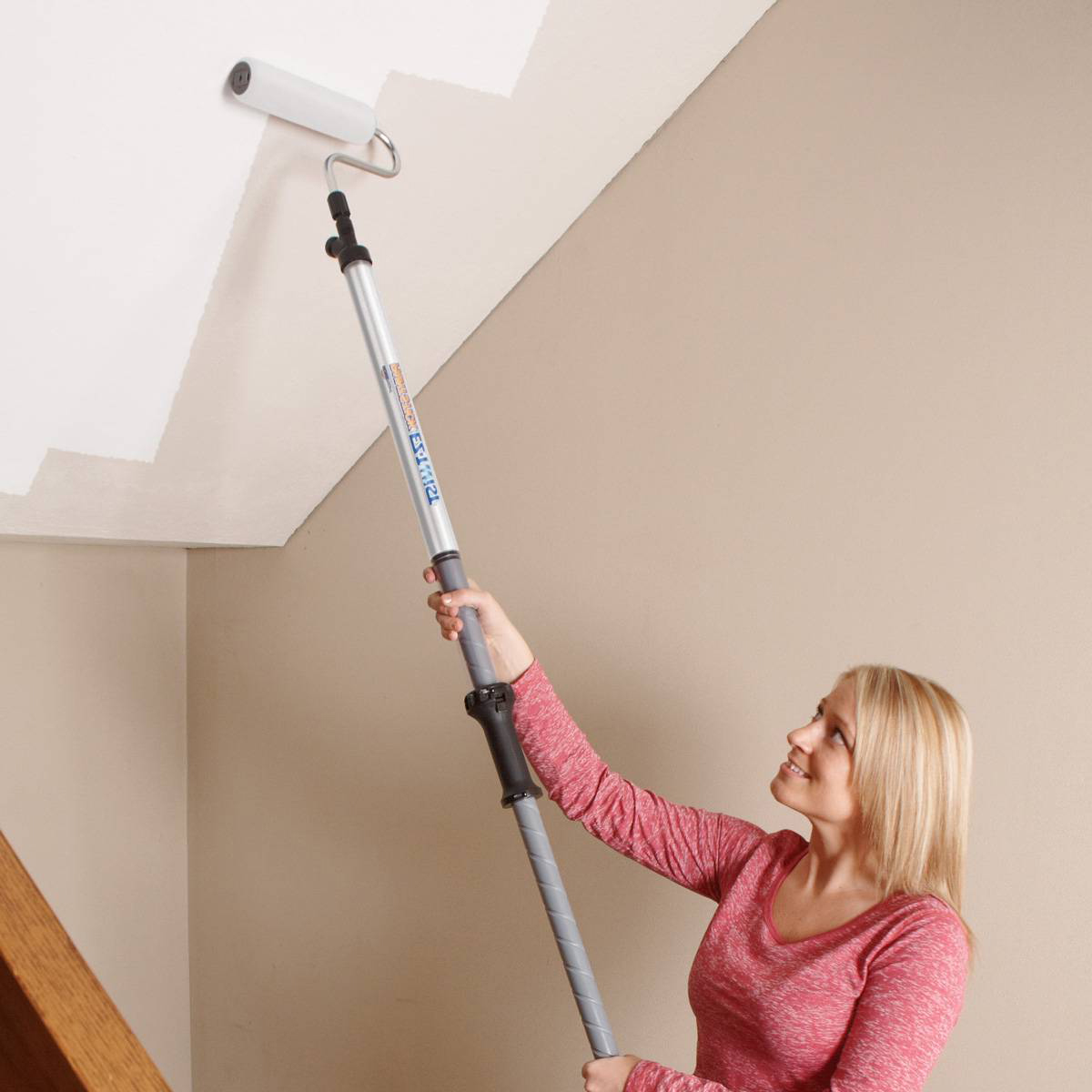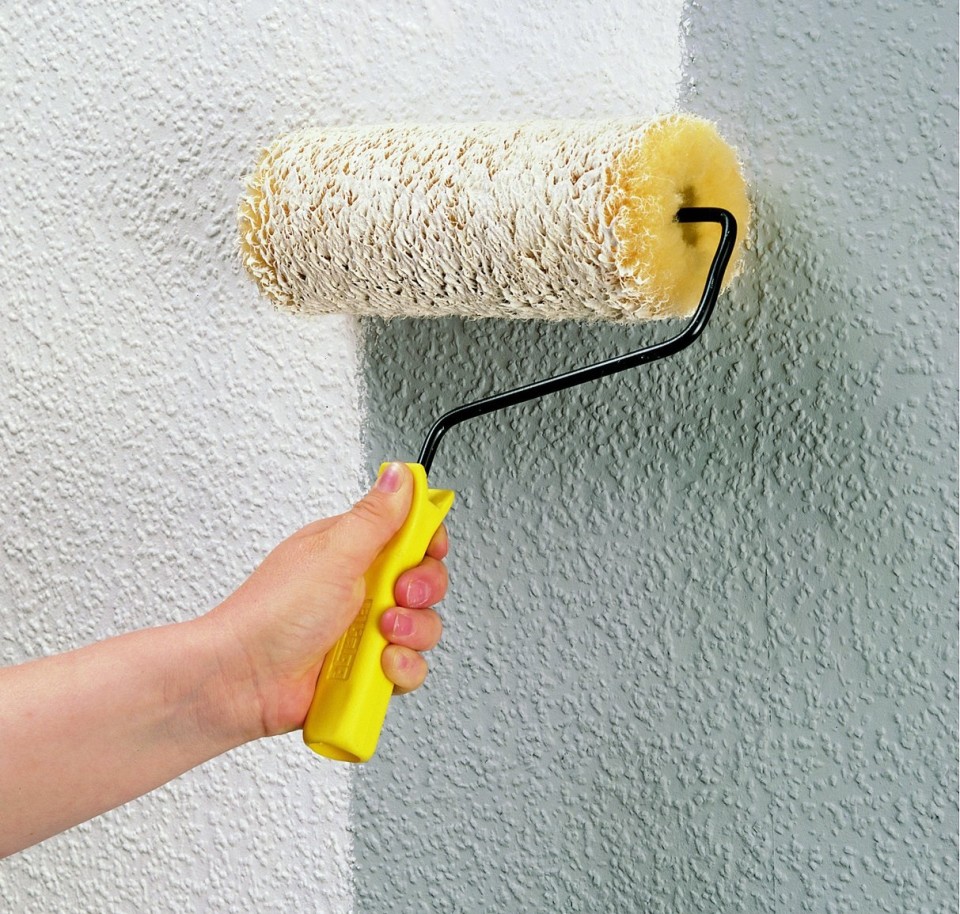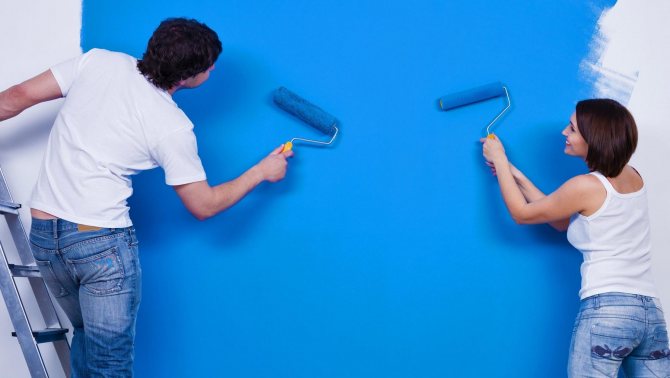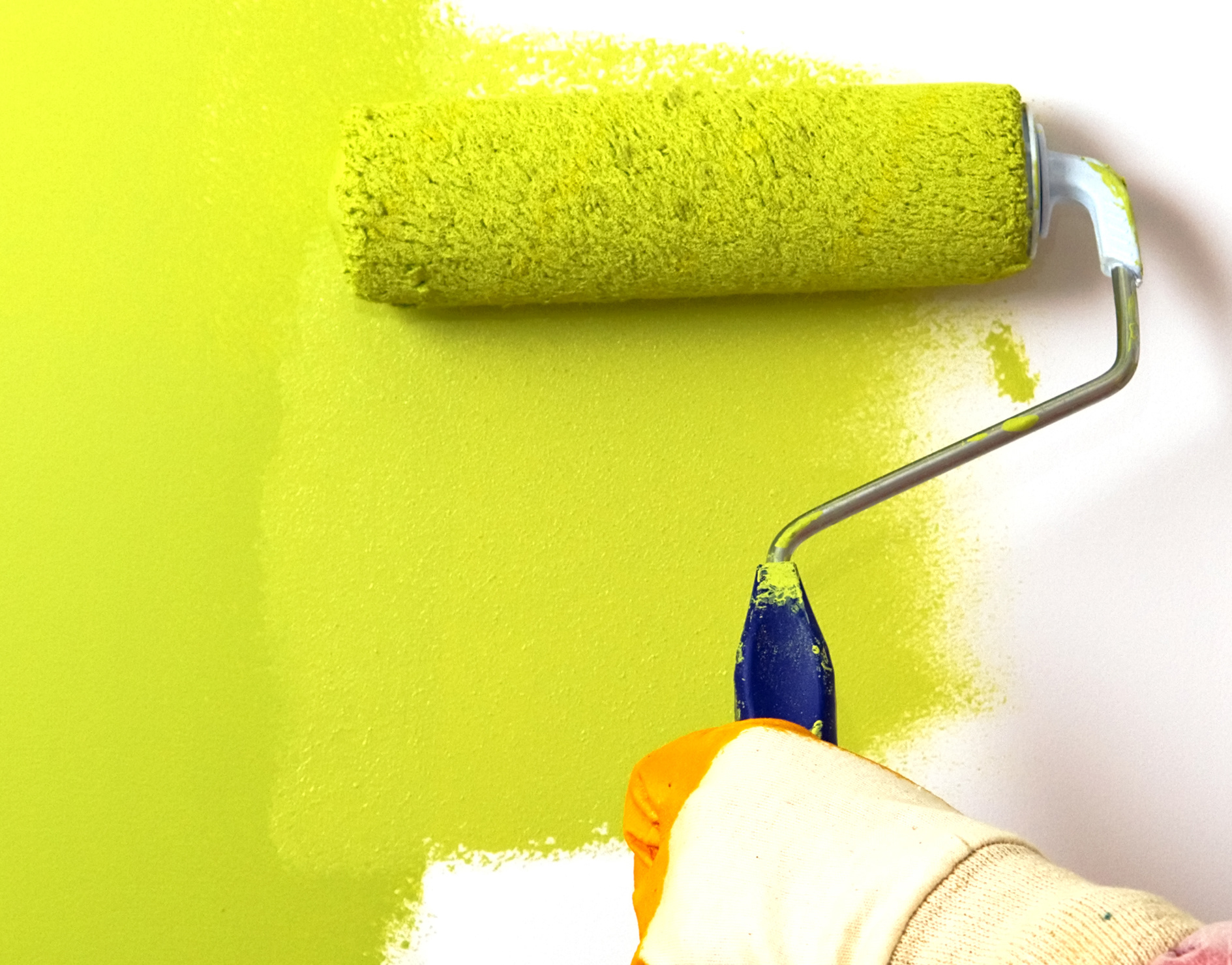Preparatory work
Paint is a thin decorative layer. It not only paints the walls, but also protects them from external influences. However, paint should be applied to perfectly flat and clean walls. The film will not hide irregularities, cracks and defects, as drywall can. This means that before painting the walls, they need to be prepared.
Removing the old decorative layer
If the walls have old wallpaper, peeled paint, whitewash or putty that is about to fall off, they are removed from the surface down to the base. This is the only way to ensure high-quality adhesion of the composition.
Wallpaper is removed with a spatula or a special compound, the paint is washed off and cleaned off with a spatula. The whitewash is washed off, and the putty is beaten off. After all the manipulations, it remains to rinse the wall and dry it.

Removing rust stains from walls
If rust spots were found during the work, they must also be eliminated. Preparing walls for painting:
- Spots and smudges are moistened with hot water.
- With a 10% solution of copper sulfate (copper sulfate), rust stains are removed from the surface.
- If they do not come off, then they are painted over with a special primer.
Wall priming
This is a crucial stage. The primer forms a structure on the surface, due to which the paint will not penetrate strongly into the walls, therefore, consumption is reduced. This improves adhesion to the surface. A roller is used for work. The composition is applied without gaps, hard-to-reach places are smeared with a brush.
The wall painting technology says that after the first layer of soil has dried, you need to apply another one. This is the last step in surface preparation. It remains to wait for the last layer to dry and start painting the walls. But before that you need to decide on the color and choose the type of paint.
How to paint walls with relief paint
The embossed texture will depend on what fillers are added to the paint and what sizes. You can choose the right one according to the samples that are sure to be displayed in the store.

You can apply relief paint with a wide brush, making strokes not horizontally and vertically, but chaotically. You can also paint with a spatula to smooth out the wallpaper. Also used for this purpose are rollers with coarse pile, embossed surface, or with additional elements. For example, fabric ribbons can be tied to a large pile.


The exclusive method of applying paint allows any variation: with a large comb, a crumpled plastic bag, with the palm of your hand.

Painting walls is a creative process. Don't be afraid to experiment. If something goes wrong, you can always redo it. Better yet, practice on the walls of, for example, a garage or basement beforehand.

Preparatory work
Before painting the walls with water-based paint, it is necessary to prepare the surfaces. The fact is that such paint is not suitable for decorating walls treated with whitewash or oil paint.
Removing old whitewash and paint
If the layer of whitewash is thick, then it will be necessary to make many shallow notches over the entire area of the wall, moisten the surface abundantly with water and leave for half an hour. After that, wet the coating again and wait until it gets soaked. Then just remove the whitewash with a spatula, and at the end wash the walls with a sponge. If the layer is small, then you can do without notches.
Whitewashing after wetting can be easily removed with a metal spatula
If the walls were previously painted with water-based paint, then the process of removing it is the same as in the case of whitewashing.But if oil paint was used, then removing the coating is more difficult. In most cases, a building hair dryer helps: with its help, the surface is heated, after which the material is scraped off with a spatula.
If the paint is too old, the hair dryer may not help. Then the technology of removal using chemical washes is used. You need to open all windows and doors in the apartment to create a draft, put on work clothes, rubber gloves and a respirator. Soak a cloth in solvent, treat the surface with it, wait for the specified time and rinse the material off the wall. This process must be repeated until a clean base remains.
The safest way to remove oil paint in all respects is the use of a construction hair dryer.
Also, before painting the walls with water-based paint, it is permissible to use mechanical paint removal methods. The easiest is to sand the surface by hand or with a grinder. If you have the necessary tools at hand, you can use a drill with an attachment in the form of chains or a crown for drilling the socket outlets.
Putting and priming
If the walls are perfectly flat and there are no cracks on them, then this point can be skipped. But, as practice shows, such situations rarely happen, more often preparation is required. It is necessary to tap the wall with a hammer to identify weak points, then inspect the surface and pick out the cracks with a spatula to remove small fragments from them. If large potholes have formed, they are sealed with cement-sand mortar. Then a starting putty is applied to the entire area with a spatula, after which the surface must be primed and a thin layer of finishing putty is applied. At the end, the walls are processed with sandpaper or a sander.
Perfect alignment of walls with putty is a difficult task, so it is better to hire professionals
How to choose colors
 The selection of a color scheme for a room is often based on the warmth / coldness of the room. When the windows face south, the room is visually cooled by shades of blue, purple, green. If the room is located on the north side, then warm shades of yellow, red, brown are better suited.
The selection of a color scheme for a room is often based on the warmth / coldness of the room. When the windows face south, the room is visually cooled by shades of blue, purple, green. If the room is located on the north side, then warm shades of yellow, red, brown are better suited.
Wall surface type
Water-based coating is used for wood, concrete, brick surfaces. Apply to walls, ceilings, plaster and plasterboard. Regardless of the type of surface, an important factor in achieving an ideal result is thorough mixing of the emulsion
In addition, you should pay attention to the recommendations in the instructions for the paint: for example, if a water emulsion requires dilution with water, then it is better not to neglect this manipulation for an even coating
Number of paints
The standard layout for a room is a palette of three shades. A variety of modern colors allows you to choose a range of colors of the desired brightness or pastel, as well as visually modify the feeling of space in the room. So, light tones expand the space, dark ones narrow it. This technique can be used in combination to visually raise the height of the room when choosing dark walls and a light ceiling.
Processing degree
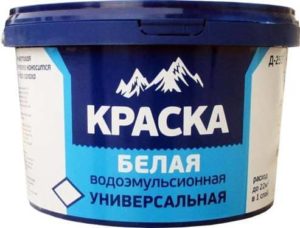 The degree of pretreatment determines the subsequent adhesion of the paint to the wall. With insufficient processing, the water emulsion holds up worse.
The degree of pretreatment determines the subsequent adhesion of the paint to the wall. With insufficient processing, the water emulsion holds up worse.
If the absorbency of the wall surface is incorrectly calculated, painting may require more materials.
The degree of processing must be calculated in advance, since the volume of tinted paint depends on it.
How to paint the wall?
In order for the paint to lay on the wall with a good even layer, it is necessary to use only good painting tools.
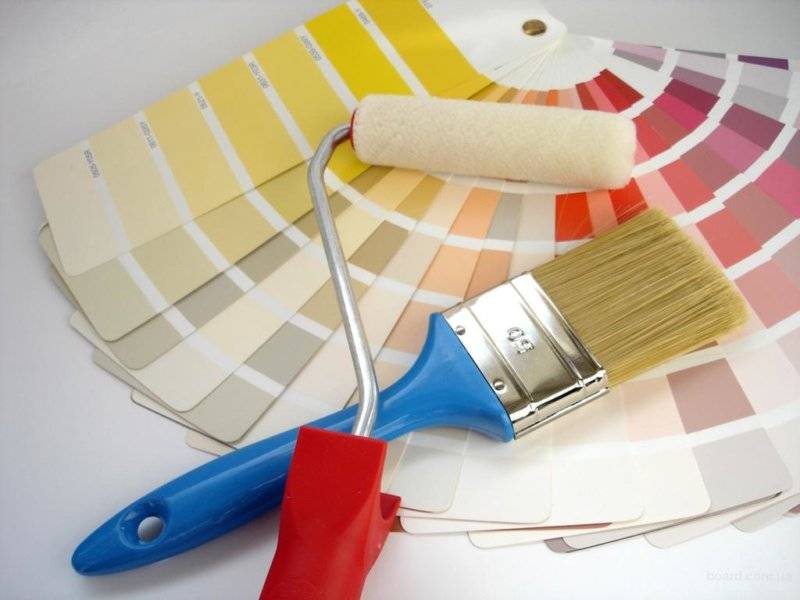
Spray.This option is not suitable for untrained people, using a spray gun is very difficult to paint a wall without preparation, but a skilled person will do it quickly and easily. This requires a compressor and a spray gun.

Roller. This method is very simple and anyone can handle it. The main thing is to choose the right roller. Fur rollers should not be used for flat walls, because when the paint dries, traces of fibers will be visible. Smooth walls are best painted with a foam roller or short-haired roller.

A brush is an essential item for any painting work. Brushes come in a wide variety of sizes and materials. Even if you paint with a roller, you will need a brush to reach hard-to-reach areas.
Advantages and disadvantages
The positive aspects of using this staining material include:
- It is very easy to apply on any previously plastered surface - concrete, wood, gypsum concrete. Brushes and rollers can be easily washed with water after use.
- This paint is easily diluted as the main solvent is water. Thanks to this dilution, it becomes safe and non-toxic, therefore it is recommended for interior work, even in rooms with closed windows.
- It differs from all other types of paint in that it dries faster than all other types.
- After painting, there is no unpleasant smell in the room for many weeks, as after using other types of finishing materials.
- Water-based paints differ in that they are not susceptible to peeling if all the rules for storage, application and preparation of the surface for painting are observed.
- An important feature is environmental safety for humans. This coating is non-toxic, not harmful to humans, without a strong chemical odor.
- Dirt from surfaces painted with certain types of water emulsion can be easily washed off with water and any detergent.
- Also important features are incombustibility and increased resistance to the effects of various alkalis.
- Certain types of water emulsion are recommended for rooms with high humidity - for a bath or a kitchen, but not only because they have increased water-repellency, but also because they are breathable, as they easily pass air and steam through their layers.
- This type of paint has antibacterial properties.
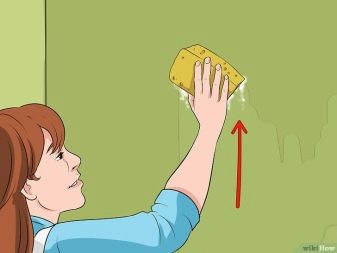

- The service life depends on the specific type of paint. Currently, you can pick up one that will not lose its presentation for 20 years.
- Some types of water emulsion have such a density when stained that they easily mask cracks up to 2 mm.
- The water emulsion is suitable for any interior solution, since it can be easily tinted even on its own, and the variety of colors and the possibility of using them in different percentages with paint gives such a spectrum of colors and shades that makes it possible to realize all the dreams and fantasies of professional designers and amateurs in the repair.
- Low price and excellent quality allow VE paints to compete with many types of wall and ceiling decoration for any type of repair work.
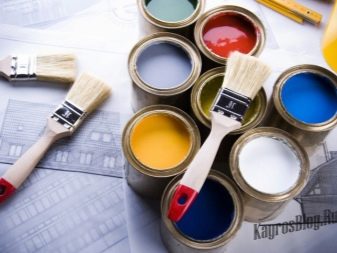
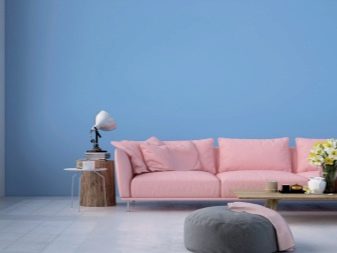
This type of paint also has disadvantages:
- The use of water emulsion is impossible at subzero temperatures, so the minimum temperature limit is up to +5 degrees Celsius. Already at 0 degrees, it freezes and loses all its properties.
- Some types of paints are characterized by a short service life, but these types of emulsions are becoming rare and are being ousted from the market by more durable paints.
- Not always suitable for metal or glossy surfaces due to the large amount of water in their composition.
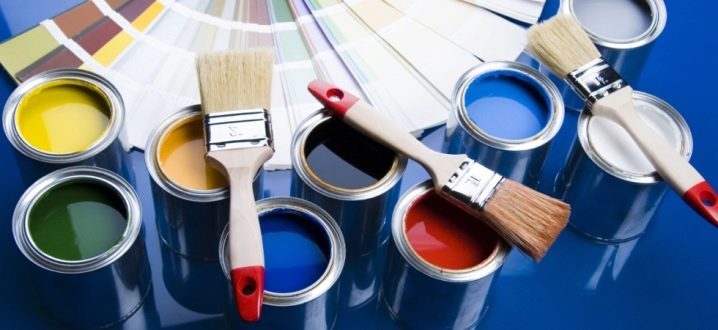
Technology for painting walls covered with wallpaper
The best option for painting with water emulsion is non-woven wallpaper - they are dense, they tolerate excess moisture well, without getting wet through and through.It is still better to cover glass fiber with latex paint. The main technological features are outlined below.
- When gluing the walls, do not allow glue to get on the front side of the trellises, after which they must dry completely in the absence of drafts.
- For new wallpapers, the tone of the dye can be any; tinting is done as described earlier. Protect unpainted areas, not forgetting about window slopes.
- Textured wallpapers are painted with a roller with a long nap, smooth coatings with a short nap tool that absorbs liquid solution well. The corners are processed with a 10 cm long roller nozzle, the rest of the surface is 25 cm
- For the first (primer) layer, the paint is diluted with water - up to 10% of the total volume of the solution, the second time the tapestries are covered with undiluted dye. Any type of wallpaper withstands 5 - 10-fold coloring (glass-fiber wallpapers are more durable in this regard). What paint to paint the walls after putty? After that, they begin to lag behind the walls - then they are removed and new ones are glued.
An interesting effect is achieved through a special technique:
- wash off the paint with a sponge from the protruding relief of an already painted canvas - a play of shades is obtained;
- after similar rinsing, allow to dry, then apply a contrasting color.
How to repaint walls with water-based paint
- Wallpaper recoloring. The surface is cleaned of dust, dirt, degreased. Pick up paint of the same type as previously used. In terms of color saturation, the coating should be the same or slightly darker. If you want to give a lighter shade, you will have to paint the wallpaper twice.
- Repainting of plastered walls. Using a spatula or sandpaper, clean off the old paint, after wetting the surface. Then apply a layer of penetrating primer with a brush and let it dry for an hour. If necessary, make alignment with putty, after 6 hours, clean the wall with a mesh. After re-priming, paint is done.
How the walls are painted with water-based paint is explained by the video film. For cosmetic repairs, working with water-based paint is a winning option. Wall painting is done quite quickly, allowing you to change the boring interior while saving energy and money.
Additional Information: How to paint walls with water-based paint on old water-based paint
The wall painting procedure itself is not that difficult, but it requires careful surface preparation. You can do the work yourself, but the work will take a lot of time and effort. How to properly paint the walls with water-based paint, we will analyze in the article.
To understand how walls are painted with water-based paint without streaks, it is worth considering a few nuances. To do this, you need to know the rules for its application, to do the preparatory work. If you do everything in accordance with the technology, then the result will be a high-quality painting.
What paint to paint old furniture with your own hands? But how to paint the walls so that the result is pleasing to the eye for a long time? Let's figure it out.
With a brush, paint the corners (stripes 3 - 5 cm in each side of the rib), areas around window and door frames, areas behind the radiators. For solid painting, this tool is not used, as it leaves streaks. A roller with a foam rubber “coat” is not suitable because bubbles form on the painted surface.
An important point is to create the optimal temperature for painting, which should not exceed twenty-five degrees Celsius. The composition is applied in a thin layer, it is better to carry out the procedure several times. There is a break between this for a few hours.
The first question that many people who want to make repairs with their own hands face with their own hands is whether it is necessary to dilute the emulsion with water? It all depends on many factors, but the paint in the store is sold ready-to-use. Consider in which cases it is necessary to dilute the water-based paint:
- Masking tape-scotch, for fixing the protective film on walls and floors, for enclosing painting areas - if necessary.
- In addition, you need to prepare work clothes and protective equipment for the skin and respiratory organs - this is a suitable suit, respirator or mask, rubber and fabric gloves.
Features of paint
As the name suggests, this type of paint is an emulsion. Its coloring elements remain undissolved until the mixture dries. After the emulsion has dried, the coloring particles take on a film structure.
The chemical and physical characteristics of the material make perfectly smooth walls an achievable result. At the same time, caring for the resulting surface is not difficult. With a damp cloth and a little effort, the finish will be clean and look good. Water-based compositions are suitable for children's rooms, delicate surfaces, varieties of this paint are also used in bathrooms.

Due to its characteristics, the raw materials stratify during storage: the fillers and the aqueous solution are separated. A construction mixer, which is used immediately before applying the paint, will help. In a bucket, it sometimes has to be diluted with water, since the wet component can evaporate.
What is the best water-based ceiling paint?
So, after weighing all the advantages and disadvantages, you decided to paint the ceiling with water-based paint. There is a huge number of paints on the market that differ both in composition and in the manufacturer. How to understand which paint is right for you?
Water-based paints are of the following types:
• acrylic;
• latex;
• mineral;
• on a polyvinyl acetate basis;
• on a silicone (silicate) basis.
The most affordable in the price segment are polyvinyl acetate paints. They are intended for painting walls and ceilings in dry rooms. Due to its composition, the resulting coating does not lend itself to wet cleaning.
Latex types of paint are considered the most expensive. They give a beautiful, durable, smooth glossy surface that is not afraid of moisture.
The most common are acrylic water-based paints. They are suitable for almost any room, creating a strong, durable, abrasion-resistant coating.
Silicate paints get their name from the composition, which includes liquid glass. They are used for painting plastered, concrete and stone surfaces. The use of silicone paints does not require preliminary priming of the surface. The advantages of this type of paint include increased vapor permeability and resistance to the formation of fungal coatings. It is often chosen for painting the ceiling in the bathroom and in the kitchen.
When choosing a paint, it is important to decide what kind of appearance you want to achieve, to cover which surface it will be used, and also in what conditions it will be used. At the same time, you should not completely trust the recommendations of the seller.
Your main task is high-quality and inexpensive repair work, and his - earnings. So that, once you get to the stand with paints, you are not completely at a loss, we will give several recommendations on choosing a good paint.

Pay attention to the label!
And not only pay, but read carefully. On the label, the manufacturer provides comprehensive information on the purpose of the paint, method of application, average consumption, quality characteristics of the final coating
It is worth paying attention to such characteristics as material consumption per 1 sq / m and the degree of surface coverage (saturation or transparency of the final layer)
Remember, advertising and general information is written in large print on the label. Only by carefully studying the footnotes and annotations can you get a more complete picture of the quality of the paint. Here are some examples of common markings.
"High resistance to dry abrasion" - the resulting surface is not suitable for wet cleaning.It must be wiped with a dry cloth, possibly using a vacuum cleaner.
"For dry rooms with reduced operational load" - this type of paint is suitable only for rooms with low humidity. It is not suitable for greasy cooking vapors or high humidity, such as in a bathroom.
"High resistance to abrasion" - the created coating can be damp cleaned, however, the use of detergents is not recommended, because they can compromise the integrity of the coating.
"Has dirt-repellent properties, high resistance to abrasion during intensive washing" - the best option, the resulting coating easily tolerates wet cleaning with the use of a mild detergent.
With the help of water-based paints, various effects can be created - glossy and semi-gloss, matt and semi-matt. The advantage of matte paint is the visual increase in the height of the ceiling and the hiding of small irregularities and surface defects. The matte surface is more dirty and difficult to clean. It is easier to care for a glossy coating, it is more wear-resistant, but emphasizes all the defects of the ceiling. The ideal option would be to choose intermediate - semi matte or semi glossy coatings.
It is also worth paying attention to the place where the paint is sold. Water-based paint is sensitive to sudden changes in temperature
When frozen, it changes its structure and becomes unsuitable for further use.
For the ceiling, it is worth choosing paints with a special marking "for the ceiling." They are characterized by increased distribution and adhesive qualities, they set almost immediately and do not form drops on the ceiling.
How to paint different types of wallpaper?
Allow new wallpapers to dry well before painting. It usually takes 24-48 hours after sticking them on the walls. If the repair was carried out more than 2-3 days ago, then you can start painting at any time.
The biggest concern is the paper covering. But with careful roller work, even this fragile material will not suffer. When painting paper wallpaper, you can also use a non-contact method: using a paint sprayer.
The first stage is painting over the corners of the room, the places where the walls meet the ceiling or plinth. If it is possible to remove the skirting board, sockets, decorative door slopes, then it is better to do this before painting the walls. But in old buildings, you will have to paste over the edges of these interior details with masking tape. Such a measure will protect the surfaces of parts from the ingress of water-based paint, which is more difficult to wash off after drying.
You need to paint over difficult places with a soft paint brush, not trying to press hard on it. Walls near doorways, corners, rosettes and other protrusions should be painted over by hand to a width of about 5 cm.Without waiting for the paint to dry, proceed to the next step:
- Pour a little dye into a dish and roll it out with a roller over the ribbed surface to soak the pile well.
- Start painting in the middle of a small area in the upper corner of the wall. Move from the center to the edges, capturing part of the previously painted stripes.
- When the paint on the roller dries up, roll it several times over the water emulsion poured into the cuvette. Continue work in the specified sequence.
You need to paint 1 wall in 1 step, preventing the paint from drying out along the edges of adjacent areas. When applying the emulsion to a new area, it is necessary to grasp with a roller 1-2 cm of the already painted surface. So the paint will lay in an even, continuous layer.
Next, dry the surface and apply another 1 layer of dye. When working, observe the same conditions as when treating the surface for the first time.
How to choose a color scheme
Assortment of coloring agents:
- color scheme with a metallic or pearlescent sheen;
- universal pastes for enamels;
- concentrates with a liquid consistency;
- pigment pastes.
Universal coloring pastes are suitable for epoxy, nitrocellulose and polyurethane enamels. Pigment is used with wood and lumber.
For water-based emulsions, the maximum content of coloring pastes and colorants is about 20%. At the highest value, the saturation will be maximum, and the treated coating will not suffer from chemical attack.

The tinting pigments themselves are of natural or inorganic origin. The first group has a brighter and deeper color, but the compositions with them do not have high lightfastness. The surface will be unprotected against exposure to alkalis. Natural colors include umber, lapis lazuli, ocher, manganese, etc. Artificial colors such as carotene or rhodopsin give the mixture high lightfastness, but leave much less color solutions.
Before purchasing, you should find out what the final result will be, and for this they use special catalogs. Exceeding the permissible concentration will lead to a change in the properties of the paint, and due to too little content, the raw materials will often have to be interfered with.
Conclusion
Water based paint is considered the least difficult option in terms of choice and effort. Buyers select silicone, silicate, polyvinyl acetate, and acrylic solutions, the latter sometimes containing latex additives. It can be said that there is not much variety on the market, but almost every type of mixture has persistent options. People find the right water-based paint for their specific needs. Coloring emulsions are used mainly inside buildings, and outside they use those that are not "afraid" of bad weather. As a rule, solutions are applied to the cleaned surface, while tint or leaving the original color. Before painting, the walls are putty and primed, and in the process, at least a 2-layer coating is formed. Craftsmen use rollers and spray guns, as well as brushes for finishing touches. If desired, a complex texture is made on the coating and in this case a thick mixture is chosen.

